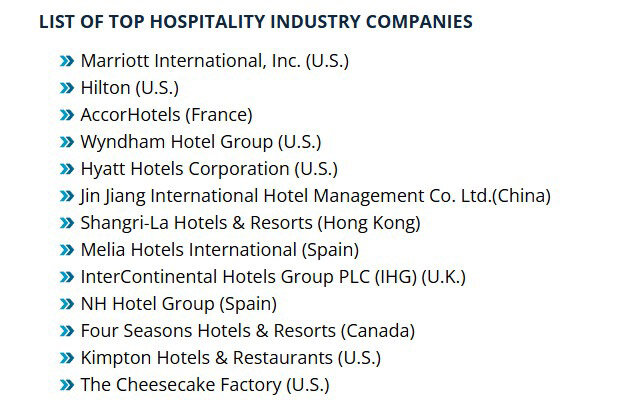читайте также
 Italy May End Tax Relief on Rental Income: What It Means for Landlords and Investors
Italy May End Tax Relief on Rental Income: What It Means for Landlords and Investors
 Luxury Travel Takes Off: How Demand Is Changing and Where to Find ‘Quiet Luxury’
Luxury Travel Takes Off: How Demand Is Changing and Where to Find ‘Quiet Luxury’
 Airbnb shifts all fees to property owners
Airbnb shifts all fees to property owners
 Most Punctual Airlines of September 2025: Who Arrived on Time and Why It Matters
Most Punctual Airlines of September 2025: Who Arrived on Time and Why It Matters
 Ten Years to a Passport: New Citizenship Rules in Portugal
Ten Years to a Passport: New Citizenship Rules in Portugal
 Top 25 World Economies 2025: Who Shapes Global Growth
Top 25 World Economies 2025: Who Shapes Global Growth
Global Hospitality Industry Market Overview

The global hospitality industry witnessed strong growth in 2024, as highlighted in a report by Business Research Insights. Experts forecast that this segment will continue expanding actively through 2032, maintaining a high compound annual growth rate (CAGR) throughout the period.
Industry Characteristics
The hospitality industry combines activities and businesses providing services to customers in hotels, restaurants, and bars. This sector includes any enterprise where primary revenue comes from selling food, beverages, or accommodation services. Hospitality is not merely the relationship between host and guest—it’s an essential element of the restaurant business, tourism, and a broad range of related services.
Staff in this industry aim to provide maximum comfort, memorable experiences, and pleasant service to guests, showing empathy, patience, and strict adherence to hygiene and safety standards. Neglecting these aspects can lead not only to revenue loss but also to significant reputational risks.
Pandemic Impact and Recent Trends
The COVID-19 pandemic delivered an unprecedented blow to the global hospitality industry, sharply reducing demand worldwide compared to pre-pandemic levels. Lockdowns and travel restrictions halted many tourism and hospitality services. Millions of people could not travel, effectively freezing many segments of the industry.
Supply chain disruptions also caused significant operational challenges for hotels and related services. Despite this, the industry has been recovering rapidly in recent years, recording a significant CAGR rebound. Demand is surging, with key markets returning to pre-pandemic levels.
The hospitality sector is now integrating modern technologies to enhance operational efficiency and improve guest experiences. Key areas of technological adoption include:
NFC technology for data exchange and instant payments
Infrared sensors to optimize internal operations
Robotics for delivering room service orders and performing auxiliary tasks
These innovations not only increase hotel efficiency but also significantly elevate convenience for guests, making services more modern and personalized.
Hotel Industry Investments Surge Amid Tourism Revival
Hospitality Market Segments
By Type
Lodging Accommodation
Driven by demand for convenient and affordable options for travelers, this segment spans various formats—from hostels and short-term rental apartments to full-service hotels.
Food and Beverage
Grows in line with increased tourism and demand for diverse food and drink options. It includes restaurants, cafes, and venues that offer not just food service but unique atmospheres, customized menus, gourmet cuisine, and innovative formats.
Travel and Tourism
Plays a pivotal role in organizing trips for travelers, covering everything from accommodation and dining options to transport and ancillary services for personalized travel experiences.
Entertainment Industry
The fastest-growing segment in hospitality, fueled by demand for immersive and exclusive leisure activities. This includes concerts, festivals, sports events, cultural programs, and theme parks.
Convention Centres
Encompasses large multipurpose venues for business meetings, conferences, banquets, and events, including halls, auditoriums, outdoor spaces, and more.
By Application
Individual Segment
Focused on personalized services for guests, ensuring comfort, respect, and a welcoming atmosphere with attentive, tailored service.
Business Segment
Covers hospitality for business events like receptions, banquets, and other professional gatherings, provided within the context of justified business needs.
Market Dynamics and Growth Drivers
Growing disposable incomes, higher living standards, and diverse hospitality offerings—from budget to premium—are making hospitality services accessible to wider audiences. Globalization, industrialization, and rising per capita income are boosting hospitality market growth as more people choose to travel.
Online travel agencies (OTAs) and mobile apps have transformed how consumers book trips and accommodations. There’s a rising trend toward unique lodging experiences and immersive travel, as travelers increasingly value memorable experiences over simple travel logistics.
Amid this evolution, the hospitality sector is embracing smart technologies and AI solutions to streamline operations, analyze guest preferences, and craft personalized marketing strategies.
Restraining Factors
A major barrier to growth is the high initial cost of implementing modern technologies, both in physical properties and cloud infrastructures. Challenges include not only financial outlays but also the complexity of integrating various applications into hotel operations.
The industry also faces significant risks around data breaches and cybersecurity. Unauthorized access to guest data poses serious reputational and legal risks. There’s growing concern about sharing information across partners and industry networks due to fears of security lapses. Ensuring secure data processing, storage, and anonymization is crucial to prevent access by third parties or competitors.
Regional Overview
North America
Leads the global hospitality market, fueled by higher disposable incomes, social media-driven travel sharing, and growing travel enthusiasm. The U.S. hospitality sector significantly drives market dynamics, supported by increased travel spending, vibrant tourism activities, natural attractions, national parks, and government-backed tourism initiatives.
Europe
Ranks second globally. High urbanization rates, active business and leisure travel in countries like the UK, Germany, Spain, Italy, and France drive demand. Tourism remains a crucial revenue source, with business and leisure travel creating strong traffic in major cities and popular destinations. The EU’s high living standards further bolster travel spending and the average transaction size.
Asia-Pacific
Shows the highest growth rates, primarily due to economic expansion in India, China, and Japan. Governments actively promote tourism and cultural development. The region also sees rapid growth among major hotel chains, with nearly half of new operators linked to partnerships with the top five global brands. Growth factors include low interest rates, limited new construction, and high operating and labor costs.
Key Industry Players
Market leaders are expanding into developing regions with high growth potential. They invest heavily in modern tech solutions—like in-room smart services and digital concierge systems—to enhance guest experience and operational efficiency.
These players increasingly emphasize sustainability, acquiring green certifications to appeal to eco-conscious travelers and access new markets.
Their growth strategies include partnerships, business expansion, mergers, acquisitions, and collaborations. Many companies launch new products and services to boost customer loyalty and business growth.
Top players highlighted in the report include Marriott International, Inc. (U.S.), Hilton (U.S.), AccorHotels (France), Wyndham Hotel Group (U.S.), among others.

Conclusion
The hospitality industry is experiencing robust development, and analysts predict this momentum will continue in the coming years. The way travel and hospitality services are organized is evolving, driven by improved service accessibility and new technologies.
Key players are investing heavily in solutions designed to deliver highly personalized guest experiences and operational efficiencies. The market is set for solid growth, especially as tourism has fully recovered post-pandemic and continues to expand.





